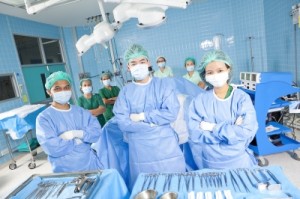 Most mothers who are pregnant with their first child don’t think about Cesarean sections much. Even though two-thirds of births in America are vaginal deliveries, medicated or unmedicated, one-third of all births are Cesarean sections. 1 That’s an alarming statistic, when the World Health Organization recommends just ten to fifteen percent of births should be Cesarean sections. 2
Most mothers who are pregnant with their first child don’t think about Cesarean sections much. Even though two-thirds of births in America are vaginal deliveries, medicated or unmedicated, one-third of all births are Cesarean sections. 1 That’s an alarming statistic, when the World Health Organization recommends just ten to fifteen percent of births should be Cesarean sections. 2
Even with such a high percentage of Cesareans, the United States pales in comparison to other parts of the world. China has a staggering forty-six percent of Cesarean births, followed by Paraguay with forty-two percent and Ecuador with forty percent. 3
The three main reasons for a Cesarean section include fetal distress, an abnormal or difficult labor and delivery, or a previous C-section. 4
So why the rising rate of C-sections in America? Some guesses include more multiple births and the growing number of older mothers who have high-risk pregnancies.
However, the Cesarean rates have increased in all groups of women, regardless of age, number of babies, health condition, or ethnicity. 5 Other speculations for the surgical increase include doctors’ malpractice fears; larger babies born to obese mothers; not as many VBACs (Vaginal Birth After Cesarean) being performed; not enough attempts to support physiological labor (for example, not as many vaginal breech births are performed anymore); or too many labor interventions are part of labor, including fetal monitoring, epidurals that are given too early, or more inductions. 6 Interestingly, only nine percent of births were induced in 1990, but twenty percent of births were induced in 2003. 7
Cesarean risks
The rising rate of Cesarean sections should be a concern to expectant moms because the procedure is not the safest or healthiest birth option. For one, Cesarean-born babies have a greater chance of having breathing problems – a trip down the birth canal in a vaginal birth normally helps stimulate a baby’s lungs. (Amazingly, once a baby heads down the birth canal, a surge of adrenaline prepares a baby to breathe by opening his or her lungs and drying out his or her bronchi.) 8
For mothers, Cesarean sections require general, spinal, or epidural anesthesia, and these anesthetics can cause adverse reactions. Other risks include increased blood loss, infection, or injured organs.
After the surgery is over, Cesarean mothers have a greater risk of uterine scarring that can endanger future pregnancies by causing miscarriage, placental problems, ectopic pregnancies, as well as a doubled risk of stillbirth. And the need for a hysterectomy because of excessive bleeding is sixty times higher in women who’ve had multiple Cesarean sections. 9
Another consequence is a mother’s negative feeling about her birth experience – especially for women who have had emergency Cesareans. 10 Several medical studies have shown that mothers who have experienced spontaneous vaginal deliveries – and even mothers who have had scheduled Cesareans – have positive feelings about their birth experiences. However, mothers who have given birth by an emergency Cesarean section are more likely to experience posttraumatic stress, grief, and depression. 11
Trying to prevent a C section
Is there any hope for mothers who don’t want to become a Cesarean statistic? One of the best ways to avoid the surgery is to find an obstetrician with a low rate of Cesarean sections. By asking potential obstetricians a few questions at the beginning of your pregnancy, you’ll be able to gauge their differing birthing and medical philosophies. Don’t be afraid to shop around. Not every doctor approaches childbirth the same way, and you will feel more comfortable when you’re in agreement with your doctor.
Other tips to try to prevent a Cesarean are:
- Avoid continuous electric fetal monitoring. The monitoring increases the Cesarean chance by thirty-three percent. When doctors watch the baby’s heart rate, many will move to deliver the baby at the sight of any change – whether or not there is an actual problem.
- Avoid epidurals. Relaxing the birthing muscles inhibits natural pushing instincts.
- Avoid induction. Induction drugs create intense contractions which can be difficult for babies – a baby’s blood flow and oxygen can be interrupted during the longer contractions, leading to drops in a baby’s heart rate.
- Try to naturally turn a breech baby.
- Find continuous labor support from a doula or midwife – these trained professionals can assist with natural childbirths. 12
Latest posts by Hilary Kimes Bernstein (see all)
- The Day I Realized Healthy Choices Don’t Guarantee Health - July 21, 2015
- Avoid Synthetic Bug Sprays with All-Natural Repellents - July 16, 2015
- The Day I Learned I Could Cook Real Food - July 13, 2015
Leave a Reply